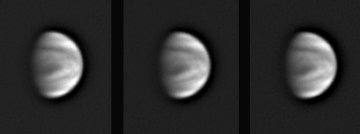 Did you miss last night's auroras? Next time get a wake-up call from Spaceweather PHONE.
Did you miss last night's auroras? Next time get a wake-up call from Spaceweather PHONE.
AURORA WATCH: Sky watchers from Scandinavia to Alaska should be alert for auroras on April 9th and 10th. A solar wind stream is due to hit Earth, and the impact could cause high-latitude geomagnetic storms.
SOLAR ACTIVITY: A large tornado-shaped prominence is twisting over the northwestern limb of the sun. Eric Roel of Valle de Bravo, Mèxico, took this picture yesterday:

This prominence, essentially a magnetic vortex filled with glowing-hot hydrogen, towers about five Earth diameters over the surface of the sun. If you have a solar telescope, take a look!
more images: from Les Cowley of the UK; from Marko Vidovic of Stojnci, Slovenia; from P-M Hedén of Vallentuna, Sweden; from John Stetson of Falmouth, Maine; from Sally Russell of Southern England; from Emiel Veldhuis of Zwolle, the Netherlands; from Britta Suhre of Germany, NRW, Dortmund; from Pete Lawrence of Selsey, West Sussex, UK.
MYSTERY IN THE CLOUDS: Seen through an ordinary telescope, Venus looks a bit dull--it's a featureless, cloud-covered orb. But if that same telescope is fitted with an ultraviolet filter, a mystery reveals itself: Venus' clouds are cross-crossed with rapidly-moving dark bands, shown here in a series of March 30th photos from Ed Lomeli of Sacramento, California:

Photo details: Celestron 9-inch telescope, DMK 21BF04 ccd camera, UV pass filter
The bands are the mystery. Some unknown substance within them strongly absorbs UV light, accounting for almost half of the solar energy trapped by Venus. Whatever is in there, it plays a big role in maintaining Venus' hellish climate; the average temperature on the surface is about 460° Celsius. Astronomers have been studying these bands since Mariner 10 first spotted them in the 1970s, but decades later no one knows the identity of the "UV absorbers." Maybe Venus Express, a European spacecraft orbiting Venus now, will eventually solve the mystery.
You can see Venus with your own eyes--indeed you can't miss it. It appears in the western sky at sunset glaring like a landing airplane. A backyard telescope reveals the point of light as a cloud-covered planet, and a UV filter reveals the mystery in the clouds. "I am using a 1.25-inch Schuler photometric UV pass filter. I also have the Baader UV pass filter, but the Schuler is a better performer," advises Lomeli.

